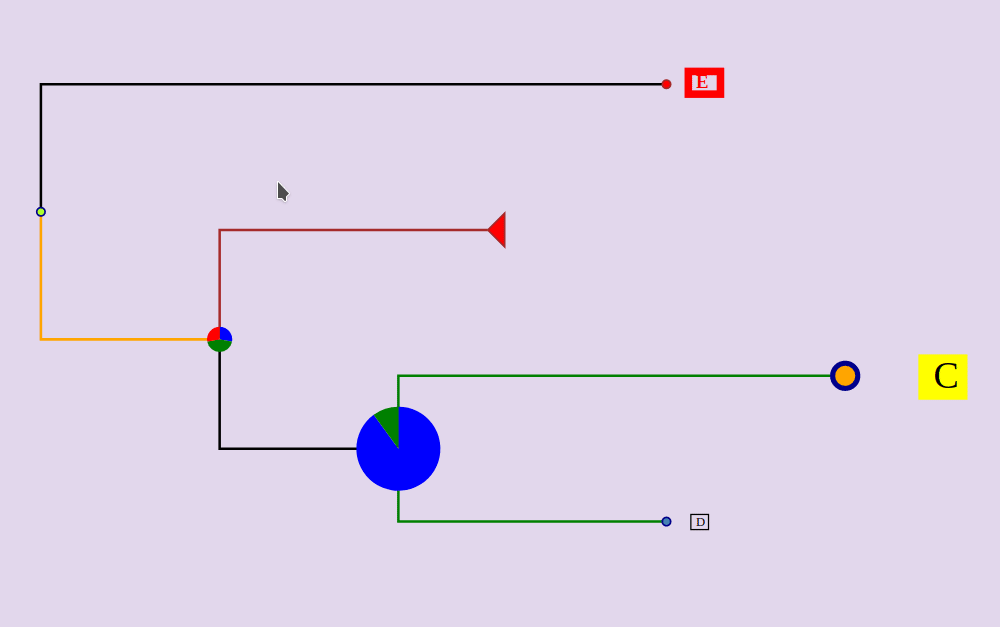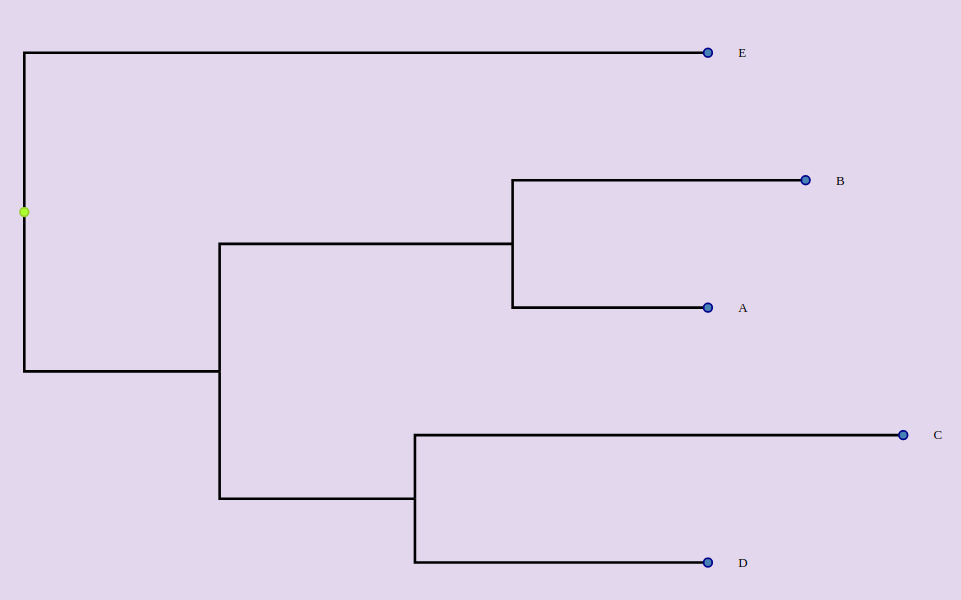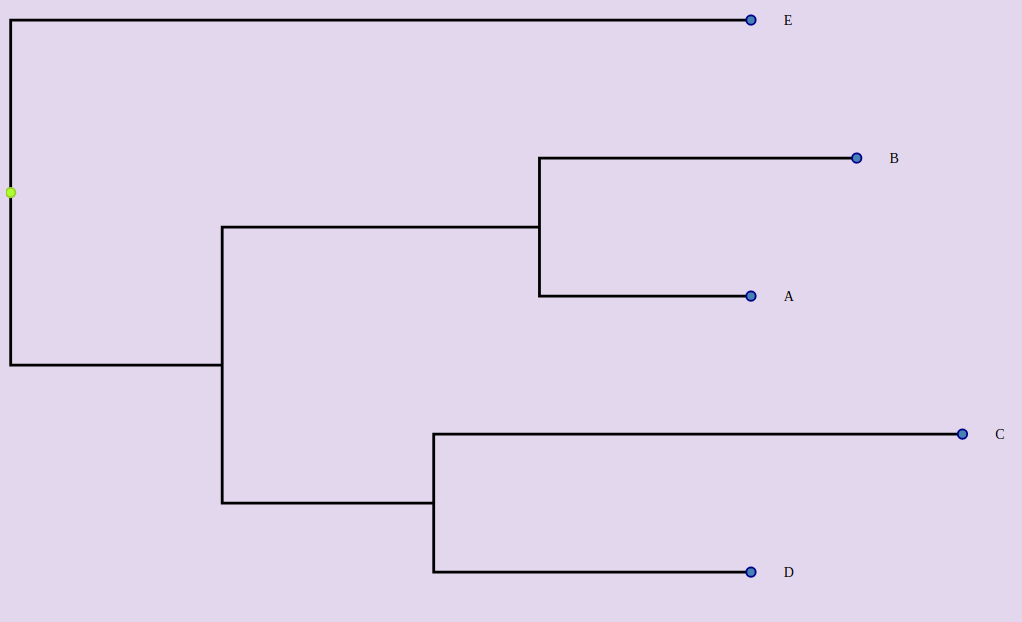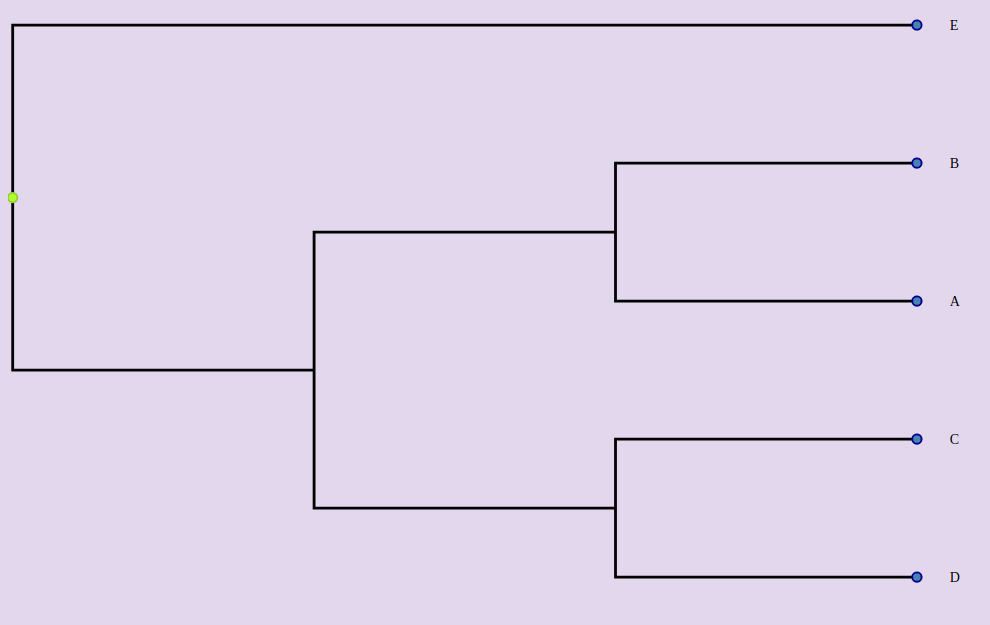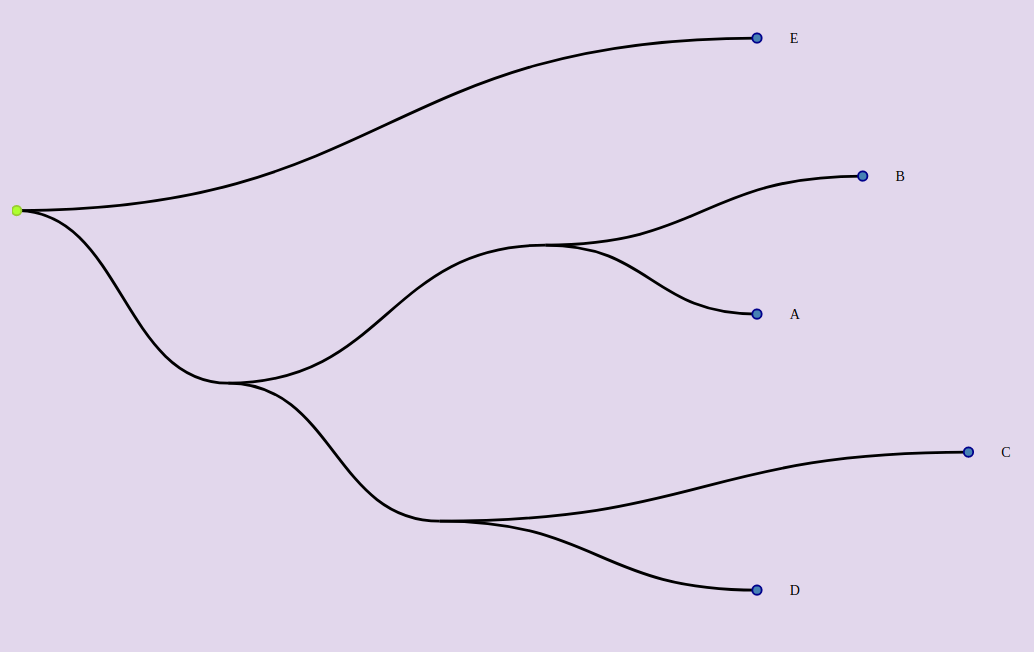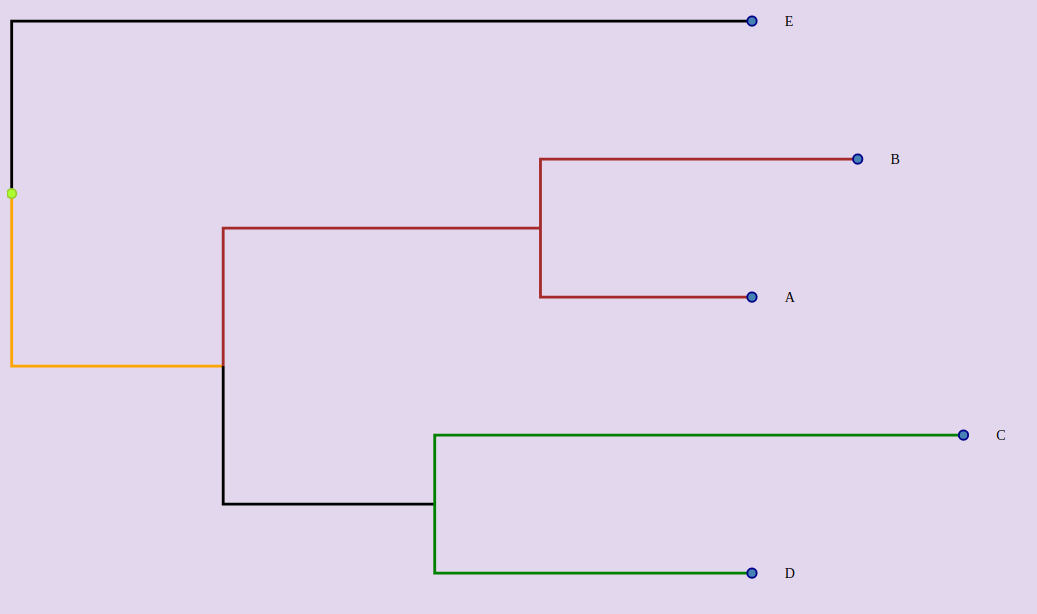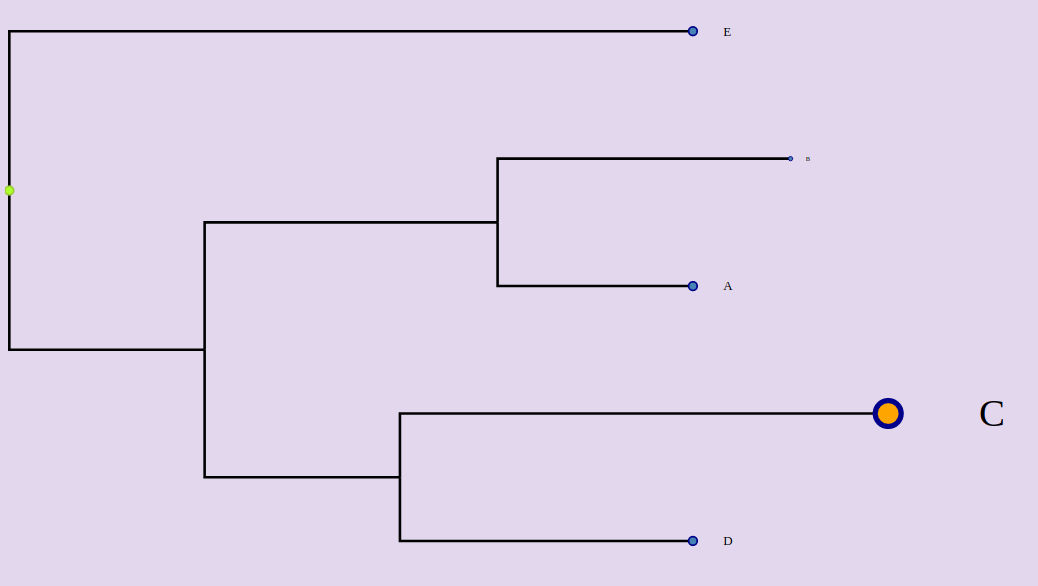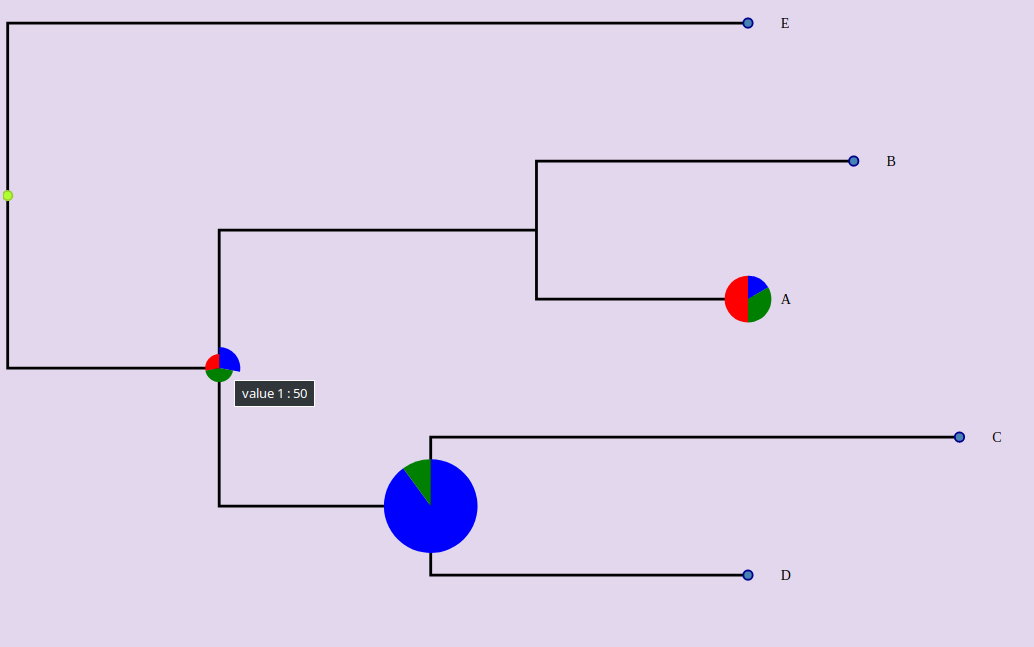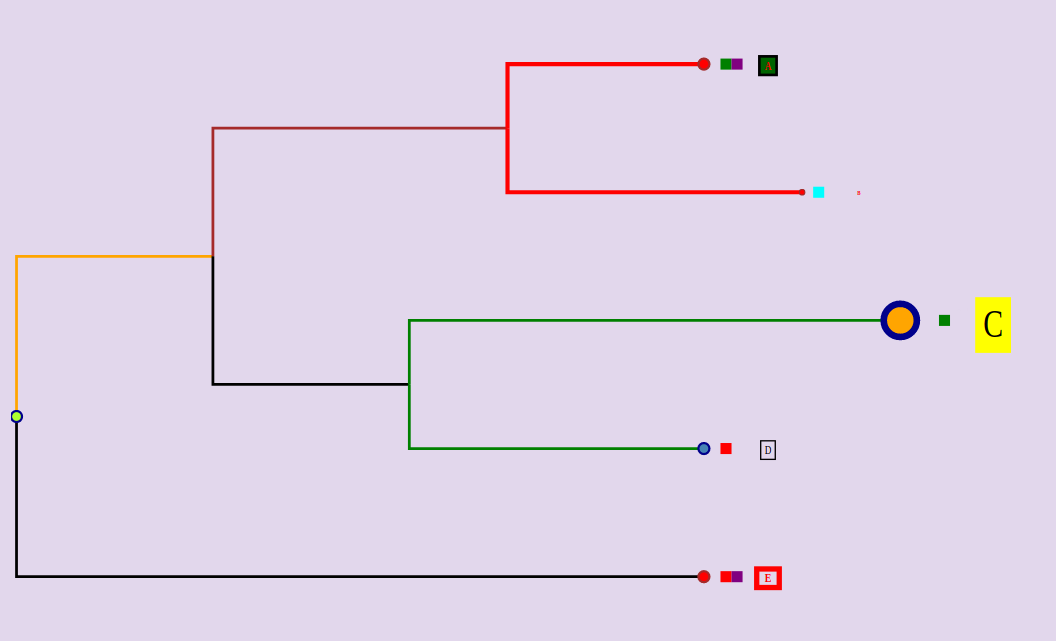Vue component for displaying phylogenetic trees
npm install --save vue-phylogram
- Sources: json or newick
- Zoom & Pan
- Display branch lengths or not
- Circular or linear layout
- Metadata on nodes, branches and labels (size, color)
- Display pies on nodes
- Collapse nodes
- Zoom with the mouse wheel
- Drag & drop to move into the tree
- Hover a node or a label to increase its size
- Select/Deselect a node by clicking on it and by choosing "Select/Deselect" in the menu
- Collapse/Expand a node by clicking on it and by choosing "Collapse/Expand" in the menu
import { VuePhylogram } from 'vue-phylogram';
The following tree can be represented by two formats : newick or json object.
<Phylogram :newick="newick"></Phylogram>
data () {
return {
newick : "(((A:0.2, B:0.3):0.3,(C:0.5, D:0.3):0.2):0.3, E:0.7):1.0"
....
Be careful, after the version 2.1.2, inputTree is not an object anymore but a String.
<Phylogram :inputTree="tree"></Phylogram>
Each node can have these attributes :
- id : if not, will be computed. Be careful, to map metadata on nodes, they must have an id.
- name : if not, the node label won't be displayed.
- length : the length of the branch before the node. If not, the length will be 0.
- branchset : the list of the nodes starting from this node. If absent, the node will be a leaf of the tree.
data () {
return {
tree: `{
"id": "ABCDE",
"branchset": [
{
"id": "ABCD",
"length": 0.2,
"branchset": [
{
"length": 0.3,
"id": "AB",
"name": "AB",
"branchset": [
{
"name": "A",
"id": "A",
"length": 0.2
},
{
"id": "B",
"name": "B",
"length": 0.3
}
]
},
{
"length": 0.2,
"id": "CD",
"name": "CD",
"branchset": [
{
"id": "C",
"name": "C",
"length": 0.5
},
{
"id": "D",
"name": "D",
"length": 0.3
}
]
}
]
},
{
"id": "E",
"name": "E",
"length": 0.7
}
]
}`
....
These props set up the generic layout :
- width (default : 600)
- height (default : 400)
- margin (default : {top:10, right;10, bottom:10, left:10})
- labelWidth : space allowed to display the labels (default : 200)
## Display a cladogram or a phylogram
A cladogram does not represent the branch lengths instead of the phylogram.
<Phylogram :newick="newick"></Phylogram>
or
<Phylogram :newick="newick" :branch-lengths="true" ></Phylogram>
or
<Phylogram :newick="newick" branch-lengths ></Phylogram>
<Phylogram :newick="newick" :branch-lengths="false" ></Phylogram>
<Phylogram :newick="newick" right-angle></Phylogram>
<Phylogram :newick="newick" :right-angle="true" ></Phylogram>
<Phylogram :newick="newick" :right-angle="false" ></Phylogram>
By default, the tree is displayed in a linear way. If you want to display the tree as a circle:
<Phylogram :newick="newick" circular ></Phylogram>
Leaves are displayed by default. To hide them:
<Phylogram :newick="newick" :display-leaves="false" ></Phylogram>
Inner nodes are hiddent by default. To show them:
<Phylogram :newick="newick" :display-inner-nodes="true" ></Phylogram>
## Display leaf labels
The leaf labels are displayed by default. To hide them:
<Phylogram :newick="newick" :display-leaf-labels="false" ></Phylogram>
The inner labels are hidden by default. To show them:
<Phylogram :newick="newick" :display-inner-labels="true" ></Phylogram>
By default, labels are displayed close to the nodes. If you want to right align them :
<Phylogram :newick="newick" align-labels ></Phylogram>
If you want to increase or reduce the width of the space assigned to the labels, use the label-width prop:
<Phylogram :newick="newick" :label-width=400 ></Phylogram>
Support values (e.g bootstrap values) can be read from newick string following the two ways described [here](https://link.
In the json object, the source node must have a key called "support":
"branchset": [
{
"id": "ABCD",
"support":85,
"length": 0.2,
"branchset": [
{
"length": 0.3,
"id": "AB",
"support":90,
"name": "AB",
"branchset": [
...
<Phylogram :inputTree="tree" :branch-styles="branchStyles">
The branches are identified by the node that they reach (type:'to') or that they start from (type:'from') or both (type:'both') (default)
branchStyles: {
CD: {
color: 'green',
type: 'from'
},
ABCD: {
color: 'orange',
type: 'to'
},
AB: {
color: 'brown',
type: 'both'
}
}
Size and color can be set for each leaf node
<Phylogram :inputTree="tree" :node-styles="nodeStyles">
nodeStyles: {
C: {
size: 3,
color: 'orange'
},
B: {
size: 0.5
}
}
},
<Phylogram :inputTree="tree" :label-styles="labelStyles">
Background, border and stroke colors can set for each label.
<Phylogram :inputTree="tree" :label-styles="labelStyles">
labelStyles: {
A: {
color: 'orange',
background: 'darkgreen',
borderWidth: 2
},
C: {
background: 'yellow'
},
D: {
borderWidth: 1
},
E: {
borderWidth: 4,
borderColor: 'red'
}
},
Hover a part of the pie to display the corresponding values.
<Phylogram :inputTree="tree" :pies="pies">
Be careful, the ids of the nodes must be well specified.
pies: {
A: {
data: [
{ label: 'value 1', value: 10, color: 'blue' },
{ label: 'value 2', value: 20, color: 'green' },
{ label: 'value 3', value: 30, color: 'red' }
],
size: 5
},
ABCD: {
data: [
{ label: 'value 1', value: 50, color: 'blue' },
{ label: 'value 2', value: 80, color: 'green' },
{ label: 'value 3', value: 50, color: 'red' }
],
size: 3
},
CD: {
data: [
{ label: 'value 1', value: 90, color: 'blue' },
{ label: 'value 2', value: 10, color: 'green' }
],
size: 10
}
}
If you want to hide pies :
<Phylogram :inputTree="tree" :pies="pies" :show-pies="false">
<Phylogram :inputTree="tree" :glyphs="glyphs">
The glyphs must be an array with this format :
glyphs: [
{
label: 'Good/Bad',
categories: [
{
label: 'good',
style: { fill: 'green' },
ids: ['A', 'C']
},
{
label: 'bad',
style: { fill: 'red' },
ids: ['D', 'E']
}
]
},
{
label: 'Yes/No',
categories: [
{
label: 'yes',
style: { fill: 'cyan' },
ids: ['B']
},
{
label: 'no',
style: { fill: 'purple' },
ids: ['A', 'E']
}
]
}
]
If you want do hide glyphs:
<Phylogram :inputTree="tree" :glyphs="glyphs" :show-glyphs="false">
If you don't want that a tooltip is displayed when a glyph is hovered:
<Phylogram :inputTree="tree" :glyphs="glyphs" :show-glyph-labels="false">
Use the "selected" props and put the node ids separateb by commas.
<Phylogram :inputTree="tree" :selected="AB,E">
Use the "selected" props and put the node ids separateb by commas.
<Phylogram :inputTree="tree" :collapsed="AB,CD">
By default, branches are not ordered (layout-mode=0) To sort the branches by ascending length:
<Phylogram :inputTree="tree" :layout-mode="1">
To sort the branches by descending length:
<Phylogram :inputTree="tree" :layout-mode="2">
-
select-nodes: when the user selects or deselect one node, returns the array of the selected node ids.
-
collapse-nodes: when the user collapses a node or uncollapse a node, returns the array of the collapsed node ids.
-
click-node
-
right-click-node
-
hover-node
-
click-outside : click outside the nodes
-
click-label
-
right-click-label
-
hover-label
npm install
npm run serve
npm run build
npm run test:unit
npm run lint
